MJ’s mantra for cricket revival
Sri Lankan legend Mahela Jayawardena speaks in detail about what it takes to make Sri Lanka the best team in the world. Jayawardena is currently is Sri Lanka Cricket’s consultant coach and believes Sri Lanka should raise the bar across all levels to achieve that.
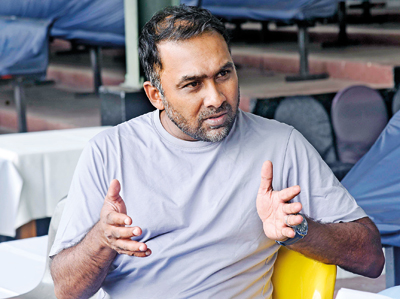
Pic by Akila Jayawardene
Q: One year into your job, how do you see the game’s progress in Sri Lanka across all levels?
After taking over, with the technical committee at the time, we produced a document on areas needing improvement. We’ve managed to implement a majority of it: the structure we wanted and the domestic provincial tournament. Some areas need further improvement but we’re at least starting to play four-day cricket. Using different venues allows us to capture the best domestic players. Yes, some of the national boys are away. But it’s fine. It provided an opportunity to others to play at good venues.
We kept some grass on SSC and the team was bowled out for 135. So, you see the holes we need to improve. They’re used to opening with left-arm or right-arm spinners. That won’t happen when we go to Australia or New Zealand. When we expose some of our cricketers who’ve scored 600 to 700 runs in the season, they’re unable to score in the first innings of a first-day wicket. We need to challenge them. But it’s a step in the right direction.
The development squad toured England. They did quite well. Most of them now represent the A team. We managed to capture some players with good batting skills. What we found, however, was that the spinners and fast bowlers aren’t still up to the mark. With Tim (McCaskill), the High-Performance Director, we will set up a fast bowlers’ and spinners’ pool once the domestic season ends.
We’ll run that pool for six months to ensure skills improvement on a daily basis—fitness, all that. Our fast bowlers and spinners are good but the skills levels aren’t good enough.
The under-19 programme is good. We now have a dedicated coaching team that’s gone around the country and identified players. There are two groups, one of which is for the 2024 World Cup. They’ll play a majority of the white ball cricket. We have a two-year programme for the team whereas we started this six months before earlier.
With the national team, more emphasis last year was on the T20 World Cup. Their skills, I think, have evolved over the last twelve months—but still not up to the level of international cricket. I think playing in Australia in the World Cup, our guys did really well. There were mistakes on the field which cost us the semifinal. This is where we need to brush up. The average age is 25 in that player group. That’s why we invested in them, knowing they can play six years of white ball cricket together—meaning, we should be able to win one World Cup in the next four to five years.
The focus shifts back now to 50-overs. Unfortunately, the way we’ve played hasn’t been consistent. Qualification becomes an issue. It was same for us in T20 cricket but we managed to automatically qualify for the next World Cup. We have to go through and, hopefully, qualify automatically (again). If not, we’ll have to qualify and then build this team for the next four-year cycle.
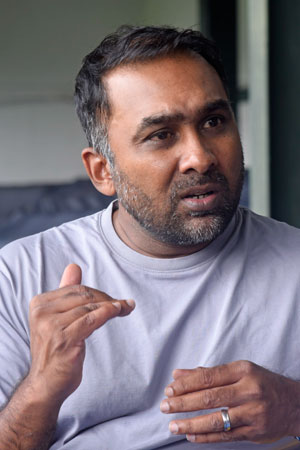 Q: What changes have you brought in and do you think these have helped Sri Lanka face the challenges?
Q: What changes have you brought in and do you think these have helped Sri Lanka face the challenges?
The change in mindset. If you see how Test cricket is being played now, our A team boys matched up to the England boys, putting them under pressure. Our Test team has done well, consistently. We can still qualify for the championship, which is great. We need to continue that and have that group going through.
But in T20 cricket and one-day cricket, where Sri Lanka struggles is the middle-overs. We slow down quite a bit. We can’t keep the tempo that other teams are keeping up.
That has to do with a few things like skills and fitness. Those teams are stronger, faster. We saw that when we beat Australia here. We really ran well between wickets and outplayed them. That’s where we won the tournament. We were brilliant in the Asia Cup. The guys gave everything. Two weeks later, at the World Cup, we were flat, because our energy levels were down. We can’t keep up that fitness consistency.
Individually, some boys are really good. As a group, overall fitness levels are lower. There’s no consistency. In a World Cup, you’re playing matches every two to three days. We’re constantly pushing the guys to get better, but they’ll take some time.
It’s not all about the 2km run or the skin-folds but about overall fitness of power, strength, agility, everything. Sometimes, a power player who’s strong and fit might not be able to run 2km the way we want him to. That’s fine because his development is to be a power player. We don’t want him coming off that. We want to say, ‘Ok, you be a power player. But you need to improve a little bit on your endurance, speed, agility and continue to have that power’.
If we can set those goals and achieve them from U-19 to national level, the standard will improve. Then we only have to focus on the skills.
Q: Do you think that our systems are synchronized to achieve all this?
No, and that’s the model we need to put in place. We brought in high-performance coaches and fitness trainers. We’re recruiting trainers and physios to implement our plan. Of 26 clubs, I’m sure about six or eight have fitness trainers under their management. That means, the guys are not doing the fitness work. If that’s our first class set up, you can imagine where the problem is. What we can now do is to try and see how to improve all this to the level at which we want to compete.
Q: Do you think we need a full time sports psychologists involved with the team?
If we can have something going at least for the time being, it would be great. We’re trying to find someone in-country to avoid the language barrier.
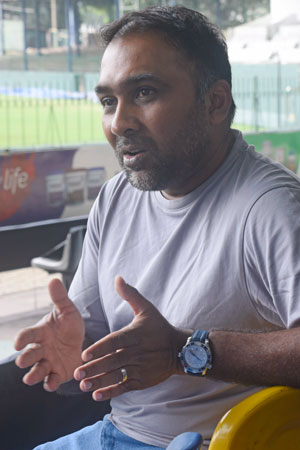 Q: You, as National Sports Council Chairman, Aravinda de Silva as head of the Technical Committee and Pramodya Wickremesinghe as Chairman of Selectors made tough calls in 2021—including introducing tough fitness profiling for national cricketers and looking beyond seniors. Do you think they impacted positively on the national team?
Q: You, as National Sports Council Chairman, Aravinda de Silva as head of the Technical Committee and Pramodya Wickremesinghe as Chairman of Selectors made tough calls in 2021—including introducing tough fitness profiling for national cricketers and looking beyond seniors. Do you think they impacted positively on the national team?
For the last ten years, fitness is where we lacked consistency with other top teams in world cricket. Even when we (Mahela) were playing, I’m not saying we were brilliant (in terms of fitness). We were behind some of the teams and were constantly trying to push ourselves to get better.
We managed to get the (present) team to a level at which we could compete. Asia Cup was a good example. Now it’s for us to keep pushing.
In 50 overs, it’s slightly different and you probably need more experience to play at that level. That means, overall, everyone must lift up their game, have fitness and all that. That’s something now being discussed.
The 50-over game is evolving, too. Guys are scoring over 350 like a par score these days. How do we achieve that? The tempo must be the same through the middle. That requires a bit more experience.
Some of the guys from our T20 group haven’t played much 50-over cricket so they need to understand the game. We still have 10 months to bring in more experience into the group and to see whether that works. Whether we need that short-term is something the Selector, National Coach and all of us must decide—how do we integrate that into the 50-over (format).
For five years, since 2015, Sri Lankan cricket was directionless. The idea behind us getting together was to find that direction and solutions to the issues we had.
Within a short period of 12 to 16 months, we managed to come to where we are now. But there’s a lot more to do. We need to be patient with system underneath, as well.
We’ve also implemented individual training for all 18 players at the HPC (high performance centre)—specific training on their weaknesses. All of them in the group have undergone this for the last six months. A lot of credit goes to those coaches and others who are tirelessly implementing this.
Q: In 2022, owing to pressure, SLC relaxed the tough fitness regime introduced in 2021.
We had to do that as the shift was too drastic for our guys. None of them had gone through it (before). With the World Cup around the corner, we needed to get the main group fitter. We have a plan now. You can see most of the guys are now up to the mark. So if we train like that for the next six months, we will be up to the mark. Thereafter, it’s a matter of maintaining those skills sets.
To a certain extent, we have to take a middle path. Going forward, we’ll make sure we try and keep certain standards so that everyone understands it’s for the betterment of the players.
With the amount of cricket these guys are playing, they will be injured if they’re not up to it. We’ve seen that. We’ve had a lot of injuries over the last six to eight years. We need to get better with fitness. That’s a must.
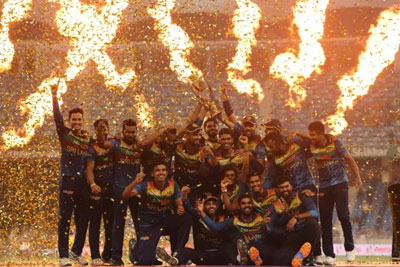 Q: These policies were criticized by some former players. Even today, some of them want a change in selection policy that would allow certain seniors to return to limited-over cricket. What’s your take?
Q: These policies were criticized by some former players. Even today, some of them want a change in selection policy that would allow certain seniors to return to limited-over cricket. What’s your take?
The three selectors have achieved a lot over the last 12 months. The win percentages in Test, one-day and T20 cricket have improved. Some of those talking about this were national selectors whose win percentages were much, much lower and they hadn’t put anything in place. There are other things that I don’t want to talk about. The reality is that these three selectors have done a lot of hard work. They’ve understood the domestic levels and introduced young, talented players giving them exposure.
I remember how they made the call for Dilshan Madushanka. He’s raw but they thought he’s got the character and put him into the Asia Cup. He was brilliant. Unfortunately, he was injured for the next two tournaments. But we know he’s an asset, going forward. These decisions are not easy and could backfire. No one’s talking about that. It’s easy for people to come out of the woodwork and say things without understanding the reality, the ground conditions.
If things need to be changed at a higher level, with the way it’s being run, it’s a different matter. That’s a policy decision. But when it comes to cricket—and how it needs to be called and improved—you need to understand where we are, what it was and make logical decisions.
We are taking responsibility—full responsibility—for what we’re doing, the implementation. If we haven’t improved, haven’t achieved what we wanted to, we will definitely walk away from this.
Q: You were talking of experience. With the World Cup around the corner, is there still room for Angelo Mathews, Dinesh Chandimal and Dimuth Karunaratne to return?
I don’t see why not. No one’s been written off. I don’t see selectors having issues with any of them. All they need to do is put their hands up and show consistent performances. And it cannot be just one-off.
It’s about investment. If you’re not getting something special from seniors at a certain age, the question is whether it’s more worth for us to invest in a youngster for two years because they’ve got the age. But if the seniors are picking up the numbers, if they’re consistent, there’s nothing wrong with them coming and playing while letting the youngsters grow alongside.
We had a different plan for T20 which we’ve executed and need to take forward. We have another one for 50-overs.
We had a successful Australian series here against a quality team. We even had Dunith (Wellalage) playing in that series exceptionally well. None of these people talking now had anything to say. When we won the Asia Cup, everyone was quiet. Yes, we had a few hiccups in the World Cup. We want to win another World Cup. We want to be successful and everything is put in place to achieve that.
Q: As a former captain who oversaw a golden era in Sri Lankan cricket history, how do you feel about the present standard of the national team?
Six years after I retired, in October 2021, I walked into the dressing room. I saw a huge difference in tactics, planning, how we worked and approached the game. When we came back from that tournament, I gave a report identifying the gaps. I saw a huge gap between what other international teams were doing, even franchise cricket was doing, and where we were as a national team. So we started to work on the framework. I see progress in the last twelve months. I see that, tactically, our team is much better. They are playing without fear in certain situations and they can get better skills-wise. Their lack of consistency was due to two things: the fear of failure and lack of fitness. Fitness is something we can control. Fear of failure is something we need to keep talking to them about. That’s why I said we need sports psychologists and others helping them to grow into better cricketers.
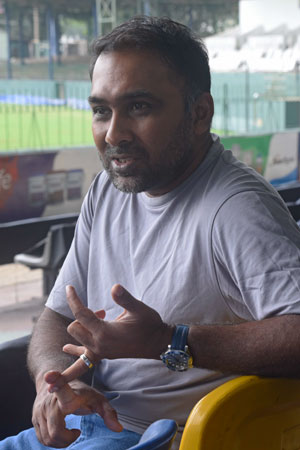 Q: You were among many former greats calling for a more robust, competitive domestic structure to improve the standard. Do you think the National Super League (NSL) is the answer?
Q: You were among many former greats calling for a more robust, competitive domestic structure to improve the standard. Do you think the National Super League (NSL) is the answer?
We have to see how the NSL is going to improve. Over the years, we’ve opted for quantity over quality. From this year, we will gradually reduce the number of domestic clubs to a target of 16-18. We’ll have two divisions, then promotion/demotion because we’re turning out a lot of under-19 cricketers. We need a platform for them to perform well on. So we can’t reduce the number of clubs, just like that. If you give it three years, I’m confident you’ll see results.
Q: The talented cricketers coming through the system don’t make the kind of impact some of the players of your era made. Why?
The international game has evolved quite fast. You can see the amount of talent coming through in other countries. That’s where we need to identify how we can improve our guys. I was impressed at how Nishan (Madushka) was playing in the team: his tempo, confidence, composure in the middle and the temperament to back long periods was brilliant. That’s why we needed to give them an opportunity straightaway. There are a couple of other young guys who’ve done well. We feel that they’re good enough. But sometimes it takes a bit more time at international level for them to come through.
You saw this in Pathum and in Charith. They took some time because they hadn’t been exposed at the domestic level. If we have the NSL and push them, they will get better. They’re already being pushed at a lower level to cope with the pressures of international cricket.
This is the first year we’re doing that. We should’ve been doing it for the last 20 years. Then we wouldn’t have had a problem because Australia and India have the same. Our first class cricketers didn’t have a four-day tournament all these years. India is playing four-day cricket at U-23 levels.
Q: Why do you think Sri Lanka was lagging in those aspects?
It’s about planning, about understanding what’s required for you to produce cricketers. Roshan (Mahanama), Muttiah (Muralidaran) and I were in the Schools Cricket Committee six years ago. We found out they were using a senior ball for under-13 and 15s. They had done that for the 2000 under-15 World Cup and hadn’t changed it. And the ICC hasn’t played the under-15 World Cup since then. But we hadn’t had the knowledge here to change the ball. We were wondering why our junior spinners aren’t able to turn the ball or why we have so many bowlers coming through with suspect action. They can’t control spin so they are just darting the ball in. And the fast bowlers coming in from under-13 who have the pace—but where the ball is bigger—don’t have the grip so don’t get the pace. Naturally, they are trying to bowl faster, resulting in a jerk in their action. All of this was because we were using a senior ball at under-15 level. It’s important to have knowledgeable people who understand the tactical and technical nature of the game.
Q: It is 27 years since the 50-over World Cup victory and twelve years since we reached a final. How long will it take for Sri Lanka to win a World Cup?
I feel that, playing in India, the conditions will help us. If we set up ourselves properly tactically and have a healthy group of players on the park consistently who play with intensity and the required tempo, I think we’ve a fairly good chance of going all the way. If not, we still have to plan for 2027 in that manner—plan now, keeping one eye on this year’s World Cup, then the next four years.
Playing in India—with our experience from T20 cricket and with players changing a few things tactically, setting the team up and making sure we understand our strengths and weaknesses, having a game plan around that—we definitely have a very good chance.
Q: When teams are scoring 350 as par scores in ODI cricket, we’re struggling to get a run-a-ball. How can this be changed?
The tempo must change. Understanding role clarity in certain stages of the game (will help). We all say we grow up in spin-friendly conditions and should be able to play spin but that our weakest point. Our average run rates are low playing spin because we don’t do it confidently. Most of our batters don’t sweep. If we can up the tempo in the middle phase, we can get to that 350 mark consistently.
We have batsmen who can be disruptive at the back end. We have a couple of good top-order batsmen with the tempo to bat at high intensity in the first ten overs. It’s in the middle 30 overs that we need to bat without losing wickets and tempo.
When you don’t rotate strike, when you don’t keep up with that level, whether you’re setting up a total or chasing a target, you tend to take risk. This means you’re looking for boundary balls. Against good quality opposition bowling attacks, it’s hard to find them.
So, the key is to ensure you’re rotating the strike. We’re running hard in-between wickets for those twos and threes. But if you don’t have the fitness to run those twos and threes and to bat for 20 to 30 overs, you tend to stay and try to hit boundaries.
That’s when we make mistakes and give up wickets. That means your total drops from 350-360 to 300 as you have to slow down after having given up wickets.
Q: Isn’t it ironic that Sri Lankan batters struggle against spin when all we’ve played were spinning tracks?
That’s where you need to go back to club cricket and find out what’s what. Sometimes, when we put certain spinners who’ve taken a lot of wickets in club cricket to bowl on good surfaces, they don’t pick up wickets. There’s evidence of it. On turning pitches, you don’t have to do much—just put the ball there, because they’re doing the work. We have to prepare better club wickets. Now we’ve got four curators who will prepare club venues, making sure we have standardized wickets.
You can have certain advantages but you can’t have really bad wickets. In the current NSL season, most matches didn’t even last the fourth day. We are playing on good surfaces and we don’t have batsmen who bat five sessions. They lack the temperament to bat those long knocks, to get a double-hundred. I haven’t seen a single match…except for Nishan who got a double-hundred against England Lions.
We’ve also not had fast bowlers holding a length consistently. They’re not used to it because at club level they don’t bowl more than ten overs in a game. Spinners are bowling 30-40 overs.
Q: The present National Sports Council (NSC) Chairman states the current Selection committee wasn’t approved by the National Sports Selection Committee (NSSC). If so, how did the NSC recommended the current selectors?
The NSC is just an advisory committee. The National Selection Committee makes the recommendations. Obviously, the Sports Minister has to sign up. I feel selection of National Selectors shouldn’t be a process where the Minister or Government gets involved in. It’s up to the national bodies to appoint those committees and take responsibility for it. The NSSC lacks expertise to appoint selectors for all 72 registered bodies. They just focus on the five main sports. The same cannot be said of all other sports. They’re deprived. They simply send names and get them signed off. That’s reality.
Our system is wrong. Our sports law was written 50 years ago. No other country has this system. Their national bodies are responsible for making sure they have a proper Selection Committee. These are democratically-elected bodies and must have freedom to do what’s best for the game.
I know our sports system is flawed. That needs to be addressed. Changes can be made by amending the sports law. How are nations who successfully competed at the Olympics or Commonwealth Games or Asian Games managing 50-60 sports in their countries? What is the implementation? How are they managing their funding, their structures? You just have to read and understand what would suit Sri Lanka, write and implement it.
Q: Did you push for those changes when you headed the NSC?
Yes, we studied New Zealand and England. We had extensive conversations with a few universities helping to run UK sports, especially the Olympic structure. We made recommendations. The initial draft was with the AG’s department. Then we had to move out, which is fine, but the challenge is for the next team to try and continue or add anything they need. The main thing we saw was, rather than having regulations and minor changes, we must amend sport law.
Q: Why does the IPL franchise not bid for Sri Lankans. We saw this during the recent WPL auction where none of the three players had a buyer?
Only 40 foreigners can be picked in IPL, that’s four each for ten teams. It’s sad we can’t get guys into that 40. During the last couple of years, we had few players getting the nod and hopefully with the consistency the national team has shown, we should be able to get in a few more. The guys have to be consistent, fit, performing and challenging with other guys and girls. Australia, New Zealand and England have been dominating the women’s record for quite some time and now India, to a certain degree. So for the Women’s Premier League, the focus was probably on them. Yes, a few of our girls were in contention but the dynamics are quite different. The majority of players are Indians and the rest they fill up with international players, where they don’t have Indian talent.
Q: How important is the use of data in cricket?
The next level of sports is artificial intelligence. Other sports already use it—elite sports, team sports–it will come to cricket very soon. We have to be ready. At the moment, we are further away from it. Even the way we analyse data is quite primitive compared to what the other teams are using. We’re introducing new things now to analyse players and teams and do strategic planning. Chris (Silverwood) has been brilliant. He’s used to that kind of stuff in England. From my knowledge of being in franchise cricket, we’ve got the same system (technology) in place here. We need to train our analysts to bring out the data the team requires in an efficient manner. There are a lot of things we need to improve, overall, not just the players.
Q: What’s the difference between being a franchise coach and national level coach?
I think national coaching is quite different because you got players for a longer period of time and you can work with them and improve them for a period of time. In franchise, it’s about the mindset and getting them clarity to play tactically better out there in the middle.


